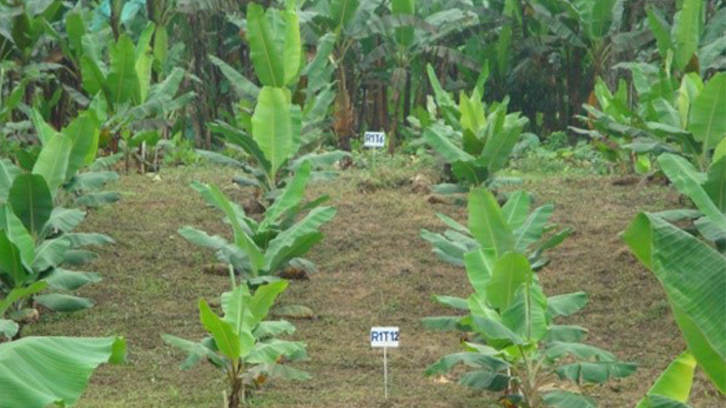How to improve environments degraded by monocultures of banana and plantain

Banana and plantain (Musa spp.) are very important crops in Ecuador. Agricultural production systems based on a single cultivar and high use of external inputs to increase yield cause changes in the landscape structure and a loss in biodiversity. This loss may be responsible for a decrease in the complexity of arthropod food webs and, at the same time, related to a higher frequency and range of Musaceae pest outbreaks (Black Sigatoka, phytopathogenic nematodes and Banana weevil). Very little is known either about the ecological mechanisms causing destabilization of these systems or the importance of the diversity of natural enemies to keep pests under control. Few studies have focused this issue in tropical ecosystems.
In the thesis by Daniel Vera two parallel studies were performed; one comparing two Musa-based agroecosystems (monocultures and mixed-species plantations) at two sites in Ecuador (La Maná and El Carmen) with different precipitation regimes to determine the resilience capacity in these areas dedicated for more than 25 years to monoculture; and another study where new plantations (monocultures and mixed-Musacea species) were designed and established at the same two sites mentioned before and also at Quevedo with a higher average annual temperature than the other two sites, to compare during two years the effect of introducing intraspecific biodiversity to improve environments degraded by monocultures of Musa sp. and counteract the damage caused by the attack of pests and diseases in the Musaceae, without producing environmental alterations in the production systems of this agricultural sector and improving the environmental quality of them.
According to the results from the first study, arthropod abundance, as indicator of the above mentioned disturbances, was higher in the mixed system at both localities which was clearly associated with the quality of the soils. In addition, we found hymenoptera species with predatory or parasitic characteristics over the pests present in the agroecosystems under study. These highly beneficial species were more abundant at the locality of La Maná than in El Carmen. The mixed type of production system provides plant diversity which favours arthropod abundance and permits lower agrochemical application without yield penalties in comparison to the monoculture.
In these mixed systems we also found more worms and microorganisms and a lower rate of infection of pests and diseases compared to monoculture systems.
In the second set of experiments we found that in terms of productivity the ratio of land equivalents (LER) for mixed crops exceeded in 1.0 that of monocultures in the studied years, indicating that the mixed Musacea species system produced more in respect to monocultures. Black Sigatoka infection index, the population of phytopathogenic nematodes, and the severity of banana weevil attack were higher in plots with monoculture than when mixed with cultivars that tolerate these biotic stresses. A significant positive correlation was observed between the black Sigatoka infection rate and the climatic factors of precipitation and maximum temperature.
Analysis of fungal and bacterial communities’ structure using molecular techniques (pyrosequencing) indicated that fungal diversity indexes showed significant differences associated with localities and the type of agricultural management system, while bacterial diversity indexes did not show any significance in as for Simpson's dominance and Shannon's diversity.
It was observed a great presence of the phytopathogenic fungus Fusarium oxysporum in monoculture systems, while in the mixed systems dominated the presence of atmospheric nitrogen fixing bacteria. Our study provides a fungal and bacterial inventory of the community of agricultural soils with different management and reveals the most dominant species. The type of agricultural management system (mixed and monoculture) is a determining factor that influences the structure of the fungal community but not so much that of bacteria.
From this study we can conclude that mixed farming systems are more productive, have greater biodiversity and are more resistant to pest and disease attack than monoculture based farming systems.
This thesis provides useful results for the design of Musaceae agroecosystems in tropical zones that will help to improve the regulation of pest management and thus contribute to a better quality of agricultural systems in this sector.
Facultat de Biociències
Universitat Autònoma de Barcelona
References
Tesi doctoral. Biodiversidad intraespecífica varietal para mejorar ambientes degradados por monocultivos en Musáceas, como medida de control de plagas y enfermedades, de Daniel Federico Vera Avilés. Defensada al programa de doctorat en Biologia y Biotecnologia Vegetal. Dirigida per els doctors Mercè Llugany Ollé, Carmita Suárez Capello y Ralph Wills Flowers

